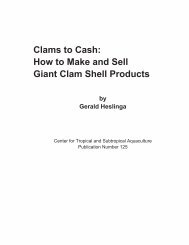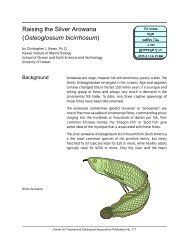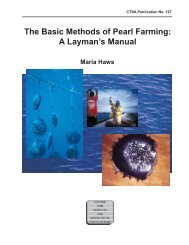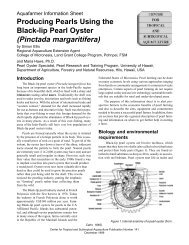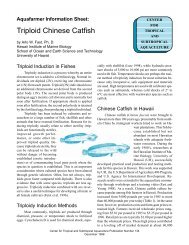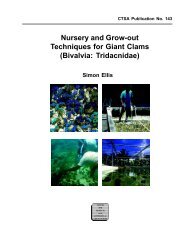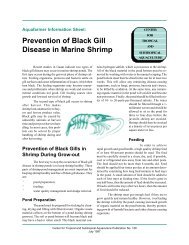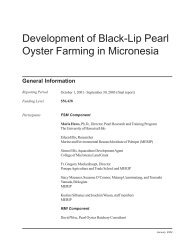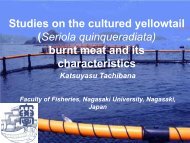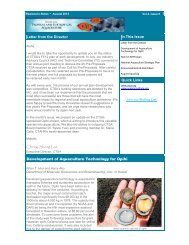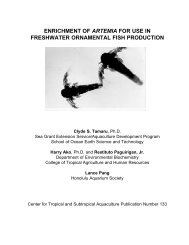Letter from the Director Cheng-Sheng Lee In This Issue ... - CTSA
Letter from the Director Cheng-Sheng Lee In This Issue ... - CTSA
Letter from the Director Cheng-Sheng Lee In This Issue ... - CTSA
- No tags were found...
You also want an ePaper? Increase the reach of your titles
YUMPU automatically turns print PDFs into web optimized ePapers that Google loves.
Regional e-Notes ~ May 2012 Vol 4, <strong>Issue</strong> 5<strong>Letter</strong> <strong>from</strong> <strong>the</strong> <strong>Director</strong>Aloha,<strong>This</strong> month marks <strong>the</strong> official beginning of our next developmentcycle with <strong>the</strong> release of our "Request for Pre-Proposals." <strong>This</strong>request was compiled based on information provided by regionalstakeholders in <strong>the</strong> recent <strong>CTSA</strong> "Priority Areas" and "Species<strong>Issue</strong>s" surveys. We greatly appreciate those who took <strong>the</strong> time toparticipate and share with us <strong>the</strong> specific challenges andopportunities for aquaculture development within our region.<strong>In</strong> addition to <strong>the</strong> FY2012 Request for Pre-Proposals, this month'snewsletter features a <strong>CTSA</strong> project update by <strong>the</strong> "Tuna Roe inShrimp Maturation Diet" project out of <strong>the</strong> University of Guam.There is also an announcement for a finfish hatchery workshop at<strong>the</strong> Oceanic <strong>In</strong>stitute, open to technicians and farmers <strong>from</strong> <strong>the</strong>U.S. Affiliated Pacific Islands (excluding Hawaii). Last but not least,this month's AquaClip.<strong>In</strong> <strong>This</strong> <strong>Issue</strong><strong>Letter</strong> <strong>from</strong> <strong>the</strong> <strong>Director</strong><strong>CTSA</strong> FY12 Request for Pre-ProposalsProject Update: Tuna Roe in ShrimpMaturation DietPacific Island Spotlight: OI FinfishWorkshopMay AquaClipQuick Linkswww.ctsa.orgwww.oceanicinstitute.orgJoin our Mailing List!As always, please let us know if you have any questions, comments, orsuggestions!Mahalo,<strong>Cheng</strong>-<strong>Sheng</strong> <strong>Lee</strong>Executive <strong>Director</strong>, <strong>CTSA</strong><strong>CTSA</strong> FY 2012 Request for Pre-Proposals: Due June 29, 2012The Center for Tropical and Subtropical Aquaculture (<strong>CTSA</strong>)requests pre-proposals for applied research that addressesproblems and opportunities in <strong>the</strong> regional aquaculture industry. <strong>In</strong>a recent region-wide survey, <strong>CTSA</strong> stakeholders identified <strong>the</strong>below strategic areas and species as <strong>the</strong> top aquaculturedevelopment priorities. Pre-proposals that target <strong>the</strong>se strategicareas and priority species will receive highest preference. However,pre-proposals that do not fall under specific priority areas butaddress <strong>CTSA</strong>'s mission will be considered in our developmentprocess. <strong>CTSA</strong> strongly encourages collaboration betweeninstitutions and agencies in <strong>the</strong> region, as well as shared funding oflarge priority projects.<strong>CTSA</strong>'s mission is to support aquaculture research, development, demonstration, and extensioneducation in order to enhance viable and profitable aquaculture in <strong>the</strong> United States. <strong>CTSA</strong> isfunded by an annual grant <strong>from</strong> <strong>the</strong> U.S. Department of Agriculture's National <strong>In</strong>stitute of Food andAgriculture (NIFA). The <strong>CTSA</strong> region includes <strong>the</strong> following areas: American Samoa, Guam, Hawaii,<strong>the</strong> Commonwealth of <strong>the</strong> Nor<strong>the</strong>rn Mariana Islands, <strong>the</strong> Republic of <strong>the</strong> Marshall Islands, <strong>the</strong>Federated States of Micronesia, and Palau.Please note: Desired outcomes and/or deliverables are included where applicable. They representindustry-identified requests and it is strongly recommended that <strong>the</strong>y be addressed in your preproposal.
FY 2012 Strategic Areas & Priority SpeciesCost Effective Locally-Made Aquatic FeedNearly all survey participants identified availability of affordable feed as one of <strong>the</strong> major constraintsin <strong>the</strong> regional development of aquaculture. <strong>CTSA</strong> would like to solicit a proposal that will develop acost-effective aquaculture feed using locally available ingredients. The major goal should be tocreate a local feed that costs less than imported feed for species currently being farmed and/orspecies identified in <strong>the</strong> <strong>CTSA</strong> survey as desired species for regional farming. These include but arenot limited to tilapia, marine shrimp, moi, Kahala, rabbitfish, freshwater prawn and groupers.Tilapia Farming Development<strong>In</strong> our recent survey, tilapia was identified as <strong>the</strong> most desired species for aquaculture farmingthroughout <strong>the</strong> <strong>CTSA</strong> region. Although most farming technology is available elsewhere, <strong>the</strong>development and expansion of tilapia farming still faces regional challenges, including but notlimited to sources of fingerlings and farming and importation restrictions of some desired species.<strong>CTSA</strong> encourages studies to develop desired strains <strong>from</strong> those that are already locally available,and cannot provide funding to introduce non-native species. We also encourage proposals todevelop locally made feed for tilapia.Rabbitfish farming developmentRabbitfish is a highly desired species for farming on almost all Pacific Islands. Currently, <strong>the</strong>rabbitfish supply for local markets is dependent on wild harvest. Although farming technology isestablished in several Asian countries, it is still not widely available in <strong>the</strong> Pacific Islands. <strong>CTSA</strong> isseeking a project to adapt, demonstrate and transfer rabbitfish farming technology to differentPacific Islands.Sea Cucumber farming technologyWith an increased demand for sea cucumber in Asian markets, natural stocks of <strong>the</strong> species havebeen over harvested in some Pacific Islands. To mitigate this problem, <strong>CTSA</strong> recently fundedprojects to transfer sea cucumber hatchery technology to Pohnpei and Yap. It is important to ensurethat any technology transferred throughout <strong>the</strong> Pacific region is adapted to local conditions, and isbeing operated wholly by local technicians. Currently, <strong>the</strong> major issues facing <strong>the</strong> development of<strong>the</strong> sea cucumber industry are <strong>the</strong> lack of farming technology and sources of seedstock withindifferent communities. <strong>CTSA</strong> is calling for a proposal to continually transfer and demonstrate seacucumber farming technology in waters around <strong>the</strong> islands, using locally desired species.Marine Shrimp farmingThe <strong>CTSA</strong> region is known as <strong>the</strong> main source of SPF white shrimp broodstock for many shrimpfarming countries around <strong>the</strong> world. However, <strong>the</strong> local shrimp farming industry is still struggling toachieve profitable and sustainable operations, mainly due to <strong>the</strong> high costs of feed, energy, labor,and transportation on most islands. <strong>CTSA</strong> is <strong>the</strong>refore soliciting a proposal for a collaborative effortbetween researchers and industry members to improve production efficiency and sustainability ofmarine shrimp technology.Marine Finfish Farming TechnologyFarming of marine finfish such as moi, Kahala and groupers has been identified as a commercialaquaculture practice with potential for growth in <strong>the</strong> region. <strong>CTSA</strong> has previously supported <strong>the</strong>development of farming technology for moi and Kahala. However, stakeholders have indicated thatexisting operations are still struggling with impeding issues, including <strong>the</strong> lack of a reliable source offingerlings, expensive feed, and <strong>the</strong> high cost of energy. Stakeholders have also indicated thatgroupers are ano<strong>the</strong>r desirable marine finfish for farming in <strong>the</strong> region. Grouper farming technologythat is currently available in several Asian countries can likely be adapted to regional conditions.<strong>CTSA</strong> will accept proposals to adapt and/or develop technology that improves <strong>the</strong> practices,profitability, and sustainability of marine finfish farming in <strong>the</strong> region.Freshwater Prawn industry<strong>CTSA</strong> stakeholders also identified freshwater prawns as a desirable species for regional farming.Freshwater prawn culture was developed in Hawaii over three decades ago. Although <strong>the</strong> numberof prawn farms has decreased in recent years, data <strong>from</strong> <strong>the</strong> <strong>CTSA</strong> survey indicated that freshwaterprawns remain a species with potential for profitable farming in <strong>the</strong> region. However, revitalizing <strong>the</strong>prawn industry will require solutions for key issues, including seedstock source and cost of feed,
energy, and labor, etc. The Center will consider proposals that will improve freshwater prawnfarming industry in <strong>the</strong> region.--Click here to view <strong>the</strong> complete announcement, which contains important details on <strong>the</strong> Processand <strong>In</strong>structions to submit a pre-proposal. If you have any questions, please contact MeredithBrooks via email at mbrooks@oceanicinstitute.org, or by telephone at (808) 259- 3176.A Value Added Approach for Tuna Roe on Guam: Can It Be Used as a Local<strong>In</strong>gredient in Shrimp Maturation Diets?Hui Gong, John W. BrownCollege of Natural and Applied Sciences, University of Guam, Mangilao, GU 96923<strong>In</strong>troductionShrimp reproductive performance parameters incaptivity including <strong>the</strong> rate of gonad development during<strong>the</strong> sexual maturation process, <strong>the</strong> frequency ofinduced spawning, and initial larval development ofpost-spawning (which relies exclusively on <strong>the</strong>nutritional reserves <strong>from</strong> egg yolk) are greatly affectedby <strong>the</strong> quality of <strong>the</strong> maturation diet. Although <strong>the</strong>nutrition requirements related to fertility and fecundityare not fully understood, <strong>the</strong> commonly used maturationdiets such as bloodworms, squids and bivalves aregood sources for promoting shrimp maturation andreproduction with bloodworms being considered as <strong>the</strong>gold standard <strong>from</strong> a nutritional perspective.However, <strong>the</strong>re are two primary concerns with <strong>the</strong>"fresh-frozen" maturation feeding regimes. One is <strong>the</strong>biosecurity concern. The fresh-frozen ingredients aresometimes collected <strong>from</strong> coastal areas, where shrimppathogens may be present <strong>from</strong> local shrimpaquaculture activities. These feed organisms may bepotential shrimp pathogen carriers, and shrimp could beinfected by pathogens through food ingestion, which isranked as <strong>the</strong> second highest risk for diseasetransmission in shrimp. Once <strong>the</strong> disease spreads via ei<strong>the</strong>r horizontal or vertical transmission orboth, <strong>the</strong> catastrophic shrimp disease outbreaks would occur.The second concern is <strong>the</strong> high cost. The costs of certified specific-pathogen-free (SPF) shrimpmaturation supplements, such as bloodworms <strong>from</strong> <strong>the</strong> United Kingdom or squids <strong>from</strong> California,USA are very high. The importation of those frozen products is both time consuming and extremelyexpensive, especially to isolated areas such as Guam. It was estimated that <strong>the</strong> landed price onGuam for <strong>the</strong> certified SPF bloodworm was over $90/kg, which was too expensive for it to be usedas shrimp maturation diet. There was a clear need to seek a local alternative supplemental feed forshrimp broodstock to sustain <strong>the</strong> industry's development.Migratory tuna species are <strong>the</strong> most important fish resource in Pacific region, with a harvest worthabout $3 billion US dollars annually. Guam is <strong>the</strong> largest tuna transshipment center in <strong>the</strong> WesternPacific. The tuna average 45 to 65 pounds. There are several loining operations on Guam thatprocess <strong>the</strong> fish before <strong>the</strong> loins are air-lifted to Japan. <strong>This</strong> produces a volume of tuna scrapswhich is estimated at 3-4 tons per week. The scraps are generally viewed as wastes and sent to <strong>the</strong>landfills at a significant cost. Tuna roe comprises 16% or so of <strong>the</strong> total scraps, and <strong>the</strong> localavailability of good quality tuna fish roe exceeds 30,000 kg annually.<strong>This</strong> project was to develop new knowledge to increase <strong>the</strong> value of <strong>the</strong> underutilized tuna roe byexploring its potential use as an aquaculture feed ingredient in a shrimp maturation diet and to do soin a sustainable manner. <strong>In</strong> this study, we assessed <strong>the</strong> nutritional and health status of fish roe anddeveloped a semi-moist maturation diet for Penaeus vannamei using <strong>the</strong> tuna roe as <strong>the</strong> major
ingredient. The diet was evaluated against o<strong>the</strong>r feeding regimes to evaluate <strong>the</strong>ir impacts inboosting <strong>the</strong> reproductive performance of shrimp broodstock.Baseline information of tuna roeSamples <strong>from</strong> 23 batches of Yellow Fin tuna roe were randomly collected and pooled for health andnutritional baseline analyses.Health statusDNA and RNA were extracted <strong>from</strong> six pooled raw roe samples, and checked for <strong>the</strong> C-1 viruses of<strong>the</strong> US Marine Shrimp Farming Program SPF list, including WSSV, IHHNV using PCR, and TSV,YHV, IMNV using RT-PCR, following <strong>the</strong> published PCR diagnostic protocols provided by <strong>the</strong>Shrimp Pathology Lab at University of Arizona. The diagnostic results confirmed <strong>the</strong> absence of <strong>the</strong>listed shrimp viral pathogens in <strong>the</strong> tuna roe samples (Table 1).Table 1. PCR results of <strong>the</strong> six randomly selected tuna roe samples.Sample # WSSV IHHNV YHV TSV IMNVUOG#1 Not detected Not detected Not detected Not detected Not detectedUOG#2 Not detected Not detected Not detected Not detected Not detectedUOG#3 Not detected Not detected Not detected Not detected Not detectedUOG#4 Not detected Not detected Not detected Not detected Not detectedUOG#5 Not detected Not detected Not detected Not detected Not detectedUOG#6 Not detected Not detected Not detected Not detected Not detectedProtocols:WSSV: Two-step nested PCR modified method <strong>from</strong> Lo, et al (DAO, 1996, 25:133-141)IHHNV: PCR described by Nunan, et al. (Marine Biotechnology, 2000, 2: 319-328)YHV: RT- PCR described by Tang and Lightner (DAO, 1999, 35:165-173)TSV: RT-PCR described by Nunan, et al. (DAO, 1998, 34:87-91)IMNV: RT-PCR nested protocol described by Poulos and Lightner (DAO,2006,73:69-72)Nutritional statusPrior to sending samples for proximate analysis, a series of experiments on drying procedure wereconducted to check for <strong>the</strong> appropriate freeze drying conditions for processing <strong>the</strong> tuna roe and tocompare <strong>the</strong> results between conventional oven drying and freeze drying procedures. With <strong>the</strong>standardized freeze drying procedure (30 gram each sample freeze dry for 48 hours), <strong>the</strong> dry matterreached 18.6% on average.Following <strong>the</strong> same drying protocol, six samples were shipped to two labs in University of Hawaii forbiochemical analysis for protein, total lipids, mineral, ash, as well as fatty acids profiles. Baselineinformation of tuna roe nutritional values indicated that <strong>the</strong> fish roe is abundant in protein (74.5% ofdry matter) and lipids (10%) (Table 2).Sample # Ash Protein Lipid(%) (%) (%)Table 2. Proximate analysis of tuna roe samplesP(%)K(%)Ca(%)Mg(%)Na(%)B(ppm)Cu(ppm)Fe(ppm)Mn(ppm)Zn(ppm)UOG#1 5.79 72.95 12.94 1.19 0.78 0.05 0.16 1.19 1 6 63 2 376UOG#2 7.46 76.99 7.95 1.42 1.27 0.05 0.14 0.88 1 5 80 2 422UOG#3 5.69 73.03 9.28 1.16 0.88 0.04 0.14 1.18 2 4 55 1 315UOG#4 7.32 73.44 16.27 1.22 0.84 0.05 0.12 0.96 1 5 64 2 344UOG#5 7.17 74.32 7.54 1.22 0.9 0.04 0.13 0.98 1 5 55 2 348UOG#6 7.28 76.09 5.97 1.28 0.94 0.08 0.13 0.98 1 5 48 1 357Mean 6.79 74.47 9.99 1.25 0.94 0.05 0.14 1.03 1.17 5.00 60.83 1.67 360.33Std.dev. 0.82 1.70 3.87 0.09 0.17 0.01 0.01 0.13 0.41 0.63 11.09 0.52 36.15The total fatty acid accounts for 3.91% ± 0.71% of tuna roe in dry matter. Previous studies on PUFAand HUFA profiles of natural foods for P. vannamei maturation suggested that three HUFA areneeded for dietary inclusion, which are arachidonic acid (ARA), eicosapentaenoic acid (EPA),docosahexaenoic acid (DHA). Bloodworms are generally considered as <strong>the</strong> gold standard of shrimpmaturation feeds, <strong>the</strong>refore <strong>the</strong> fatty acid profile of tuna roe was compared with bloodworm's inorder to assess <strong>the</strong> suitability of fish roe for shrimp maturation diets (Table 3). ARA was suggestedto be <strong>the</strong> precursor of prostaglandins, which play a role in controlling vitellogenesis. The fact that
shrimp oocyte EPA level was found to be positively related to fecundity and DHA highly correlatedwith hatching rate support <strong>the</strong>ir dietary inclusion beneficiary for shrimp maturation. Among <strong>the</strong> totalfatty acid fractions, ARA comprises 5% of total fatty acid fraction in tuna ovaries, which is slightlyhigher than that in bloodworms (4%). On <strong>the</strong> o<strong>the</strong>r hand, significantly lower EPA content waspresent in tuna roe as compared with that in bloodworm, 6% vs. 29.3%, while DHA in tuna ovariestriples <strong>the</strong> amounts in bloodworm. As a result, <strong>the</strong> EPA/DHA ratio is far lower in tuna roe (0.16) thanthat is bloodworm (2.27), <strong>the</strong> latter of which was similar to that <strong>from</strong> shrimp ovary tissue. However,<strong>the</strong> relationship between <strong>the</strong> dietary EPA/DHA ratio and shrimp maturation remains unknown.Table 3. Fatty acid levels (% of total fatty acid fraction) of <strong>the</strong> six tuna roe samples compared with <strong>the</strong> published bloodworm fatty acidprofile.Tuna Roe (Mean ±Fatty Acid Blood WormStd.dev)Myristate 14:00 0.89 2.11 ± 0.23Palmitate 16:00 7.5 22.57 ± 1.09Palmitoleate 16:1n7 3.58 3.62 ± 0.34Stearate 18:00 6.51 5.53 ± 0.23Oleate 18:1n9 7.09 14.03 ±1.98Linoleate 18:2n6 1.03 1.00 ± 0.11Linolenate 18:3n3 0.28 0.33 ± 0.06Octadecatetraenoate 18:4n3 ??? 0.39 ± 0.14Eicosenoate 20:1n11 14.9 1.02 ± 0.25Arachidonate 20:4n6 4.1 5.02 ± 1.09EPA 20:5n3 29.3 6.18 ±0.79Erucate 22:1n13 0.41 0.39 ± 0.08DHA 22:6n3 12.9 38.10 ± 2.52EPA/DHA 2.27 0.16Dietary evaluation of tuna roe based semi-moist diet on shrimp reproductive performanceBased on <strong>the</strong> nutritional content, we developed a semi-moist diet (Table 4) containing 55% proteinand 15% lipid on a dry weight basis, which possessed <strong>the</strong> suitable texture and water stability. It waswell accepted by shrimp broodstock. The ingredient cost for <strong>the</strong> semi-moist diet is about $11/kg.Table 4. Dietary composition (%) of <strong>the</strong> tuna roe based semi-moist diet and cost.<strong>In</strong>gredient Price Cost/g Composition Cost ($)Fish Roe $2.50/lb $0.01 55% 3.029Soybean meal $2.75/lb $0.01 12% 0.727Glutinous rice flour $2.00/lb $0.00 5% 0.220Spirulina $25.66/lb $0.06 5% 2.826Black algae powder $26.15/lb $0.06 2% 1.152Mineral mix $25.53/kg $0.03 1% 0.255Vitamin mix $130/kg $0.13 1% 1.300Lecithin $50/kg $0.05 3% 1.500Distill Water $0.25/gal $0.00 15% 0.008Soybean oil $5.00/kg $0.01 1% 0.050Total --- --- 100% 11.07/kgThe effect of <strong>the</strong> diet on <strong>the</strong> reproductive performance of shrimp broodstock was also evaluated anddetails are as follows. SPF P. vannamei adults (30.5g average) used for <strong>the</strong> stage I experimentwere produced <strong>from</strong> <strong>the</strong> same cross and ~10 shrimp/m2 were stocked in each 30 ton fiberglasstank (bottom area 23.6m2) with male to female ratio of 1.4:1. One month prior to <strong>the</strong> experiment,shrimp had been conditioned with feeding <strong>the</strong> two regimes (tuna roe diet and control regime A (50%proprietary commercial shrimp maturation diet, 50% Squid). We chose this specific commercialshrimp diet as <strong>the</strong> control because it had yielded <strong>the</strong> best results in boosting shrimp's maturityamong all <strong>the</strong> available dietary regimes at UOG hatchery, including <strong>the</strong> frozen squid. During <strong>the</strong>one-month stage I experimental comparison, a natural mating scheme was applied to evaluate <strong>the</strong>dietary effect of tuna roe on shrimp broodstock reproduction indexes, such as ovary maturity level,number of mating per day, eggs per spawning, hatching rate, etc. The semi-moist tuna roe dietyielded an inferior reproductive performance as compared to regime A.A new batch of shrimp broodstock was used for <strong>the</strong> stage II and III comparisons. <strong>In</strong> both
experiments, we compared <strong>the</strong> semi-moist diet with <strong>the</strong> same commercial diet alone (regime B,55.3% Protein, 9.83% lipid). During <strong>the</strong> stage II comparison, broodstock <strong>from</strong> both sexes were fed<strong>the</strong> diet, and natural mating was adopted. Results showed that similar effects were achieved onmost reproductive traits, except that significantly fewer females reached maturity level of stage IV(p
On August 6-18, 2012, <strong>the</strong> Oceanic <strong>In</strong>stitute Finfish Department will conduct aworkshop for aquaculture technicians and farmers <strong>from</strong> <strong>the</strong> U.S. AffiliatedPacific Islands. The workshop is part of a <strong>CTSA</strong>-sponsored project to establishmarine finfish farming in <strong>the</strong> CNMI and surrounding region. Only applicants<strong>from</strong> <strong>the</strong> CNMI, Guam, Palau, FSM, and American Samoa are eligible toparticipate.Hands-on, intensive training sessions will include:- Broodstock husbandry- Feeding, sex determination, tagging, spawning, egg quality criteria, eggcollection & health maintenance- Live feeds production- Production systems for algae, rotifers & Artemia- Larval rearing- System design, operation, stocking, feeding, harvest- Water quality, tank management & maintenance- Nursery/Grow-out Systems- System configuration, operation, feeding & managementParticipants will be provided with a new manual, outlining all of <strong>the</strong> techniquesand procedures covered in <strong>the</strong> training. Sessions will run 0800-1700 daily.Theworkshop is free, however participants are responsible for <strong>the</strong>ir owntransportation to/<strong>from</strong> <strong>the</strong> location, as well <strong>the</strong>ir accommodations whileon Oahu. To register for <strong>the</strong> workshop, contact Dr. Chad Callan at (808) 259-3149 or ccallan@oceanicinstitute.org. There is very limited space available, soplease register as soon as possible!AquaClip: <strong>In</strong>crease Expected in Farmed Bluefin Tuna in 2015By Chris Loew, SeafoodSource contributing editor. May 10, 2012.Kinki University, which pioneered captive tuna breeding, has teamed up with Toyota Tsusho Corp.for large-scale commercial farming for export to world markets.Kinki University is known for <strong>the</strong> Kindai brand of captive-bred bluefin, which has limited distributionin New York and San Francisco. "Kindai" is short for Kinki Daigaku, <strong>the</strong> Japanese name of KinkiUniversity.Goto Tuna Dream, which operates holding pens in <strong>the</strong> ocean off Fukue Island, in NagasakiPrefecture's Goto Island Chain, is a subsidiary of Nagoya-based Toyota Tsusho, a Toyota Grouptrading company.A first batch of 14,000 juveniles, hatched at <strong>the</strong> university's facility six months earlier, was shippedto Tuna Dream's pens in November 2011. After two months, <strong>the</strong>y were sold to aquacultureoperations in Nagasaki and Kagoshima Prefectures to be fed for ano<strong>the</strong>r three years, when <strong>the</strong>yshould reach a marketable length of 1 meter. <strong>This</strong> means a jump in sustainable bluefin can beexpected <strong>from</strong> early 2015.Click here to read <strong>the</strong> full article.The Center for Tropical and Subtropical Aquaculture (<strong>CTSA</strong>) is one of five regional aquaculturecenters in <strong>the</strong> United States established and funded by <strong>the</strong> U.S. Department of Agriculture'sNational <strong>In</strong>stitute of Food and Agriculture (NIFA) under grants 2007-38500-18471, 2008-38500-19435, and 2010-38500-20948. The regional aquaculture centers integrate individual andinstitutional expertise and resources in support of commercial aquaculture development. <strong>CTSA</strong> wasestablished in 1986 and is jointly administered by <strong>the</strong> Oceanic <strong>In</strong>stitute and <strong>the</strong> University ofHawaii.



